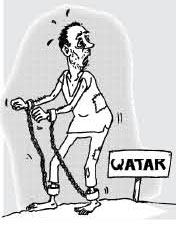Reply To:
Name - Reply Comment
 During the past 40 years the noble values of sports also have been sacrificed to the deity of money. In the 1970s, the business tycoon Kerry Packer bowled out and buried legendary figures such as Sir Donald Bradman and Sir Leonard Hutton, to make cricket a big business with match fixing also hurling bouncers at the spirit of the game. Even the hallowed Olympics suffered one of its worst blows when the International Olympic Committee said Russia had won most of its medals in 2012 because its competitors had taken banned energy enhancing substances. The worst scandal perhaps was in the most popular world sport of soccer with its governing body the Fédération Internationale de Football Association (FIFA) being rocked by multi-million dollar frauds with its long time President Sepp Blatter being given the red card.
During the past 40 years the noble values of sports also have been sacrificed to the deity of money. In the 1970s, the business tycoon Kerry Packer bowled out and buried legendary figures such as Sir Donald Bradman and Sir Leonard Hutton, to make cricket a big business with match fixing also hurling bouncers at the spirit of the game. Even the hallowed Olympics suffered one of its worst blows when the International Olympic Committee said Russia had won most of its medals in 2012 because its competitors had taken banned energy enhancing substances. The worst scandal perhaps was in the most popular world sport of soccer with its governing body the Fédération Internationale de Football Association (FIFA) being rocked by multi-million dollar frauds with its long time President Sepp Blatter being given the red card.
On Wednesday another major scandal knock down the goals and the goalposts. Amnesty International, one of the world’s most respected human rights movements, charged that thousands of migrant workers mainly from South Asia were suffering appalling treatment and were undergoing virtual slave labour in building the 2022 World Cup stadiums in Qatar.
It accused FIFA and Qatari authorities of ongoing indifference to systemic abuse of workers on stadiums that will host the 2022 World Cup. According to Britain’s Guardian newspaper despite five years of growing criticism, AI which interviewed 132 contractors working on refurbishing the Khalifa International Stadium in Doha and a further 102 landscapers who work in the Aspire Zone sports complex that surrounds it, claimed that they all reported human rights abuses.
The findings will prove controversial. Qatar’s Supreme Committee for Delivery and Legacy has made ensuring minimum standards are met on World Cup stadium projects a priority in the wake of widespread criticism of the broader conditions in which migrant labourers live and work. The labourers make up more than 90% of Qatar’s 2.1m population.
For the first time, AI said it had definitively identified mistreatment and abuses on a World Cup stadium site rather than on infrastructure projects that underpin Qatar’s ambitious 2030 Vision, of which the football tournament has become an integral part.
AI said that workers refurbishing the Khalifa stadium, scheduled to host one of the World Cup semi-finals in 2022, reported they were forced to live in squalid accommodation, forced to pay huge recruitment fees, and have had wages withheld and passports confiscated, the Guardian reported.
AI said it had conducted the interviews during three visits in the past year from February 15. The number of labourers working directly on World Cup stadiums increased from 2,000 to 4,000 in the past year and is expected to grow to 36,000 in the next two years. Most of the labourers are from South Asia, which means Sri Lanka also.
Amnesty’s report found that the vast majority alleged they had their passports confiscated, 88 had been denied the right to leave Qatar, many reported their wages being paid three or four months in arrears and there was evidence that some workers on the stadium contracted to a labour-supply company “appear to have been subjected to forced labour”.
AI said that there was evidence of workers being threatened with non-payment of wages, being deported or – conversely – not being allowed to leave Qatar because their employer would not provide an exit permit. It claimed all the men interviewed had taken out loans to pay for recruitment-related fees, often to agencies in their home country.
One metalworker told AI “My life here is like a prison. The work is difficult, we worked for many hours in the hot sun. When I first complained about my situation, soon after arriving in Qatar, the manager said, ‘If you want to complain you can, but there will be consequences. If you want to stay in Qatar, be quiet and keep working.’ Now I am forced to stay in Qatar and continue working.”
According to estimates Qatar is one of the favourite Gulf destinations for Sri Lankan skilled workers and in January last year there were more than 100,000 Sri Lankan workers in that country. The figure now and in the years to come may double or treble and the Sri Lankan government needs to closely monitor the situation because we cannot send our youth there for slave labour specially because hundreds are reported to have died in recent years.